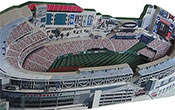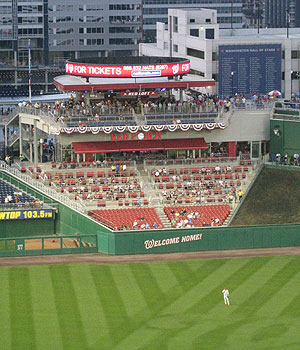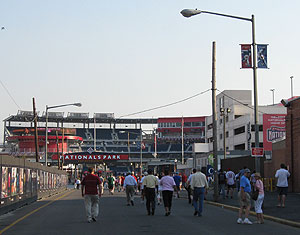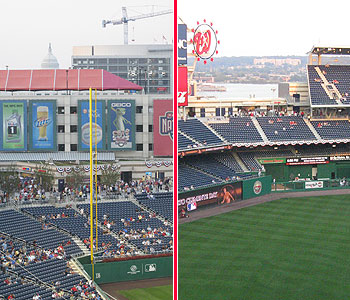
|
Nationals Park looks familiar. In a city (okay, technically a district) renowned for its unique landmarks, Washington's newest one looks awfully similar to what already exists in other big league cities.
There's an easy explanation for that: Nationals Park borrowed many of its most visible features from elsewhere. So while many ballparks feature a taste of the Major Leagues concession stand, Nationals Park itself is a taste of the Major Leagues. Its main flavor comes courtesy of Philadelphia. When I think of Nationals Park its openness reigns supreme, a trait that is also the epitome of the Phillies’ Citizens Bank Park. Each feature the now commonplace 360-degree open concourse on the lower level, and the Nationals wisely copied Philly’s split level upper deck design. In both, the 300 and 400 levels have a gap between them, which exposes the concourse to the playing field for upper deck patrons, a novel design that ensures fans in the cheap seats enjoy the type of open, sweeping views from their concourse that usually is exclusive to fans on the lower level concourse. Fans in the portion of the upper deck that wraps around the right field foul pole benefit due to another design found in Philadelphia (but pioneered in Detroit) as Washington’s right field terrace was broken off from the main upper deck, referred to by the team as the gallery level. The break between the two decks allows for the right field terrace to be lower and closer to the playing field, while the gap between the two provides fans one of the better standing room areas in a ballpark full of them.
The place to be seen is the Red Loft bar, which was modeled after Turner Field’s Chop House. Just like its inspiration, the patio of the Red Loft is congested throughout the game. The bar is perched atop the Red Porch restaurant and the two-level structure just to the left of straight away center field has become one of the ballpark’s focal points, thanks to the 360 degree LED ribbon board atop the bar and the two sections of red seats in front of the restaurant. The seats stand out as they are the only ones in the entire ballpark not to be painted blue. Despite their proximity to the Red Porch, none of the red seats are available to patrons of the first come first served restaurant. Instead, they are reserved for fans that fork over the steep prices to sit in what the Nationals call the center field lounge and club. The Red Porch and Red Loft are part of the center field plaza, which is where about 70 percent of fans enter Nationals Park. Borrowing another design from Turner Field, the outfield gates serve as the main entry point to the ballpark. Just like in Atlanta, the plaza is home to live pregame music or entertainment and a bevy of unique concession stands. If you want local flavor at Nationals Park there is plenty to be found in the category of food, with Washington's very own Ben's Chili Bowl, Cantina Marina, Five Guys Burgers, Gifford's Ice Cream, Hard Times Cafe, Noah's Pretzels, and Red Hot & Blue Barbeque all having a presence near the center field plaza. The plaza is also home to the Strike Zone kids area, where youngsters can play video games, swing from the jungle gym, hit in the batting cages, sing karaoke, or get creative in the Build-a-Bear workshop. The whole center field plaza has a festive atmosphere, which makes the strings of white Christmas-style lights that hover above it seem fitting. As can be expected from an area with so many enticing gimmicks, the plaza is congested before and after the game. To avoid the crowds, simply choose any of the ballpark’s other entrances. Oddly enough, the entrance that was designed to wow fans is the least used. That would be the home plate gate, which features a walkway lined with historical markers, each listing an important fact in the city’s baseball history with the corresponding year engraved on the concourse next to the appropriate marker. Fans that enter through the outfield gates never get to see the ballpark’s futuristic looking façade. Made from steel, glass and pre-cast concrete, the main exterior of Nationals Park has a look that no other ballpark can claim. Forget about the short lines and history lesson, fans should venture over to the home plate gate just to see the ballpark’s exterior.
From the Metro, fans are deposited onto Half Street, where scalpers unload their tickets, vendors sell souvenirs, and food and water can be bought for reasonable prices (and then brought into the ballpark). Fans walking to the ballpark from the Metro station are treated to great views of it on their approach and the pedestrian packed Half Street literally ends where the popular center field gate begins. From that gate it’s easy to tell that the playing field is sunken 24 feet below street level. No matter where you enter, free copies of the Nationals Inside Pitch are available. The complimentary booklet style program is specific to each homestand and includes a couple of insightful articles, visiting team rosters and a scorecard. Fans walking to their seats on the lower level will notice that the concrete support columns are adorned by 10-foot Arthur Miller paintings of Hall of Famers, both from Washington and around the league (plus Senators fan favorite Frank Howard). On the wall of the concourse behind home plate are lighted timelines that examine Washington’s baseball history. The Nationals deserve a lot of credit for paying homage to the sport’s history in the District of Columbia at their ballpark. In addition to what’s visible to all fans, those in premium sections are treated to something extra special. Inside of the PNC Diamond Club is the seat from RFK Stadium that was painted white to commemorate a mammoth homer hit by Frank Howard. Above the nearby bar is a replica scoreboard with the line score from Game 7 of the 1924 World Series, which displays a 4-3 victory in 12 innings by the Senators over the New York Giants. That win at Griffith Stadium secured Washington’s only World Series championship. The Nationals have placed a premium on premium seating in their new digs. The Lexus President's Club, PNC Diamond Club and Stars and Stripes Club are available only to those fans in the Presidential Seats, PNC Diamond Seats and club level suites. Each section seats 500, 1,112 and 2,500 respectively. By contrast, the rest of the lower deck seats approximately 22,000 and the entire upper deck holds 12,100. Fans in the ultra posh Presidential Seats sit in the 10 rows behind home plate and enjoy some unique perks through the exclusive use of the Lexus Presidents Club, which has a window that enables them to watch the Nationals players hit in the team's indoor batting cages. Fans in the Presidents Club can also peruse an exhibit that chronicles the history of presidential first pitches while enjoying a free gourmet buffet or drink from the Oval Office Bar. Since it’s not likely most people reading this article will be privileged enough to enjoy the perks that come with the purchase of a Presidential Seat (priced at $325 in the ballpark’s inaugural year), I am happy to report that the views from all seating sections were first class. On the subject of seating sections, it has become vogue for designers these days to say they are creating separate neighborhoods of seats within the ballpark, but all the average fan can tell in Washington is that the have-nots can't get to where the haves are. The “distinct neighborhoods” aren't noticeable at Nationals Park beyond the high-end seating sections, which regular fans can't accidentally wander into. Also not noticeable to the vast majority of fans are the Washington landmarks that the team originally wanted to be a featured part of the ballpark’s backdrop.
The U.S. Capitol dome, which is prominently featured on renderings and logos the team prepared for the ballpark’s first game, can really only be seen from a small handful of seats scattered throughout the upper deck. Even then you have to crane your neck, as the buildings that have risen on Half Street partially obstruct your view. The Washington Monument can only been seen looking outward from the third base upper level concourse and ramps or from the upper right field terrace. With the exception of a few sections on the third base side of the upper level, views of the Anacostia River are no better than they were two miles away at the fully-enclosed RFK Stadium, this despite Nationals Park being built on the shores of the river. Instead of views of monuments to our free society, the ballpark’s backdrop is filled with monuments to our freeways: parking garages. There’s one on each side of the center field plaza. As viewed from within the ballpark, the garage to the left has a large tent with picnic tables on its top level; the garage on the right houses most of the kids’ area attractions on its first level. Both are reserved for season ticket holders and have large can’t-miss banners hanging from them. From the parking garage to the right of the plaza hangs the Washington Hall of Stars banner. Washingtonians who have excelled in any sport are listed on the banner, just like they were on the right field wall at RFK. Making up for the lack of impressive exterior views, the Nationals have added some subtle touches inside the ballpark’s confines, most famously a handful of Kwanzan Japanese cherry trees. The brainchild of team president Stan Kasten and the team owner's wife, the trees were imported from a Pennsylvania nursery and planted behind the left field stands and in the center field plaza. The team touts six trees were planted in left and eight on the plaza, but I counted just five and four respectively. Furthermore, since cherry trees reach full bloom in early spring they aren't that noticeable over the latter half of the baseball season. But they are a nice and fitting touch all the same. Although DC taxpayers footed the $611 million bill to build Nationals Park, team ownership also spent an extra $40 million or so in additional upgrades prior to Opening Day. That included filling a gap between the left field wall and stands with rows of red flowers and placing a neon analog clock next to the scoreboard. The hands on the clock revolve around the team's curly W logo. Although those subtleties can be missed, the massive high-definition scoreboard can't. Measuring 102' wide by 47' tall, the 1,117,440 pixel jumbo scoreboard looms on the right-center field horizon. The out of town scoreboard is just as wide, but fixated to the right-center field wall. Behind the main scoreboard resides the part of the 360-degree concourse that makes up the Scoreboard Walk, where the open air Miller Lite Scoreboard Walk Bar is a short stroll from the Red Loft bar. Speaking of walking, that's how most fans get up the vertical ramps that zig back and forth between the lower and upper decks, but the somewhat hidden elevators and escalators will save you the workout. If you can't find them ask an usher. No write-up of this ballpark would be complete without mentioning how well fans are treated by the Nationals game day staff. They are the friendliest group that I’ve come in contact with at a pro baseball game. About the only question the rank and file team employees couldn’t answer was why a section of the hitter’s backdrop that should be full of lush green grass instead contained a dark blend that made it look like a barren field in need of irrigation. Perhaps someone in the media would know. Their press box stands out for a couple of reasons. Instead of being built above or between decks, it was placed where sections 410-416 of the upper level would be, had they not been removed to make room for the press box. And in a ballpark filled with blue seats and made with light-colored materials, painting the façade of the two-story press box red guarantees fans would notice the media’s workplace, although that view is a little more cloudy at night. That’s because a vertical strip of orange/yellow bulbs on most of the light towers emit a glow that makes the upper level appear hazy when looking in at the ballpark from the outfield. The upper level itself is better backlit because of the soft orange/yellowish glow. Just like any new modern ballpark, corporate sponsorship is a necessity to help fund the payrolls of the teams that play on the field. So it’s just a matter of time before Nationals Park is renamed to something no so pleasing to baseball fans. When it is, the Nationals expect to earn between $8 and $12 million per year from the naming rights to their ballpark. To help them find a suitable partner the team hired the Wasserman Media Group, a firm that has negotiated more than $2 billion in sports sponsorships worldwide. When a company finally comes forward to pay the team’s asking price they will be sponsoring a fan friendly ballpark called "a thing of beauty" by Thomas Boswell, the esteemed baseball writer for the Washington Post. Filled with many subtle and aesthetically pleasing design touches, Nationals Park is memorable because of its openness. But like so many of its other features, that's not unique to this ballpark. Is it a fun place to see a ball game? Yes. But a novel place? Not really.
Ballpark ConstructionGetting Nationals Park built was no easy feat, and not for the normal reasons. The saga began on September 30, 2004. That's the day Major League Baseball finally announced they had found a home for the Montreal Expos in the capital of the free world. As part of the deal that was negotiated to move the Expos to Washington, Mayor Anthony Williams promised MLB a new ballpark completely financed by public dollars, to the tune of an estimated 440 million dollars. That was all Bud Selig needed to hear to move the MLB-owned Expos to the nation's fifth-largest metropolitan area. "You've got a mayor and a city government that are really committed and competent," Selig told Thomas Boswell of the Washington Post when the deal was announced. It's unlikely the Commissioner still felt that way less than three months later, when on December 14 the D.C. Council announced they had amended the Mayor's deal to require private financing for at least half of the stadium's construction cost. And with that baseball officials halted all business activities in Washington. "I think baseball is now in jeopardy," Mayor Williams said about not just the future of a new ballpark, but the team itself. But a week later the Council agreed to an amended stadium package and the Nationals were once again back in business. The next speed bump to getting the ballpark built was getting MLB to sign a lease, which without construction could not begin. And so another round of tense negotiations ensued. From the beginning, it was assumed the new ballpark would be built alongside the Anacostia River. But as lease negotiations dragged on the District tossed out the idea that it could be built next to RFK Stadium, thereby saving taxpayers millions of dollars as the estimated cost of the stadium had swelled substantially from initial projections. Heck no was MLB's response. Finally, in early March of 2006 the two sides found common ground. The resulting agreement put a $610.8 million cap on the District's expenditures for construction of the new ballpark (although they still had to spend another $80 million to acquire the land). Baseball would be responsible for any cost overruns. To meet their financial committment, the District issued bonds to be paid back by a tax on local businesses, rent payments from the team, and revenue from the ballpark itself. With the deal in place, the pace to build the Nationals a new home quickened. The ballpark's design was released publicly on March 14, 2006. Fifty days later Major League Baseball sold the Nationals for $450 million to a group of DC businessmen led by real estate developer Ted Lerner. Groundbreaking for the ballpark took place the next day. After 18 months of political bickering, it took only 22 to finish the ballpark, which is officially listed by the team as costing "more than $611 million" after Lerner's group spent about $40 million of their own money to add some luxuries to it. All of that money was well spent, according to the U.S. Green Building Council. They are the non-profit organization that accredited Nationals Park as a Leadership in Energy and Environmental Design (LEED) Structure, making it the first major professional stadium to earn the highly coveted certification.
Location and ParkingBuilt on the northern bank of the Anacostia River, Nationals Park hopes to do for a once blighted section of Washington DC what new ballparks have done for once dilapidated areas in Cleveland, San Diego and San Francisco. After choosing a 26-acre plot of land about a mile south of the United States Capitol, the District government exercised its eminent domain powers to claim the land from businesses that the Chamber of Commerce doesn't like to promote, namely the adult-themed clubs run by Bob Siegel. After surviving Siegel's legal challenge, the building of the ballpark has begun to transform the formerly seedy industrial Southeast section of Washington DC into an area rich with desirable office, retail, dining and residential options, many of which are set to open in 2009. That meant the Nationals' first year in their ballpark was marked by the omnipresence of construction outside of it as developers built the ballpark district into a destination, something local residents never thought possible of the location near the Navy Stockyards. Now that the stockyards have been christened "historic," the Anacostia waterfront is no longer neglected, and the old manufacturing plants that were have been removed, the area is thriving with activity with only a scant reminder of its past - a single cement plant wedged between the ballpark and river. For those wanting to arrive at Washington's newest destination, the DC subway, called the Metro, is by far the best option. Parking spaces are limited, despite the presence of two large parking garages that were built just beyond the outfield. Those garages are reserved for season ticket holders and if you're not one of them the Metro’s Navy Yard station on the green line is your play and just a few minutes' walk away. For those that want to drive, your best (and definitely cheapest) option is to head to the Nationals' former home at RFK Stadium. From there the team runs the free-to-ride Nats Express shuttle, which operates continuously from at least an hour and a half before game time through an hour and a half after the last pitch at Nationals Park. The two stadiums are only two miles and about a 10-minute shuttle ride apart. Parking is free at RFK. Expect to fork over at least $15 at the Nats' new home. Nationals Park is also friendly to bicyclists. Very friendly, in fact. There are over 250 bike racks placed around the ballpark and the team even offers a free bike valet in the parking garage at the corner of N & 1st Street.
The Presidents Race Perhaps that most anticipated event at Nationals Park occurs in the middle of the fourth inning. That's when the Racing Presidents make their appearance.
Perhaps that most anticipated event at Nationals Park occurs in the middle of the fourth inning. That's when the Racing Presidents make their appearance.
Taking a cue from Milwaukee's racing sausages, Washington's version features the four presidents immortalized on Mount Rushmore - George Washington, Thomas Jefferson, Abraham Lincoln and Teddy Roosevelt. Standing about ten feet tall, team employees wearing costumes with oversized foam caricature heads take off from center field and race along the warning track until they reach the Nationals dugout. The race has gained notoriety locally because one of its participants, Teddy, has yet to win. Fans have taken to chanting "Let Teddy Win" and there's even a blog devoted to the 26th President's racing failures. What started as a computer-generated animation on RFK Stadium's video board in 2005 has now become a big enough deal that The Presidents Race has its own sponsor, GEICO, and the larger than life mascots have each had their own bobblehead doll days. Standings are even kept (but not always up to date) at the Nationals' website. The first live Presidents Race took place on July 21, 2006 and has been run before the Nats come to bat in the fourth inning at every home game since. On the rare occasions that the game lasts at least 13 innings the Racing Presidents take to the warning track again. As a testament to their popularity, the Racing Presidents (often referred to as The Rushmores) are prominently featured at Nationals Park and greet fans in the center field plaza before the game and pose for photos during it.

Nationals Park Footnotes - Facts & Figures
| ||||||||||||||||||||||||||||||||||||||||


 And make no mistake, Nationals Park has plenty of places for fans to stand, including three levels of marble countertops that were erected above the hitter’s backdrop.
And make no mistake, Nationals Park has plenty of places for fans to stand, including three levels of marble countertops that were erected above the hitter’s backdrop.
 The reason most don’t is because they arrive at the ballpark via the green line of Washington’s efficient subway system, the Metro. Nationals Park is two blocks south from the Metro’s Navy Yard station.
The reason most don’t is because they arrive at the ballpark via the green line of Washington’s efficient subway system, the Metro. Nationals Park is two blocks south from the Metro’s Navy Yard station.
 The Nationals acknowledged in the ballpark’s inaugural program that “only several thousand seats have a view of the U.S. Capitol dome and Washington Monument.” Even that’s a stretch.
The Nationals acknowledged in the ballpark’s inaugural program that “only several thousand seats have a view of the U.S. Capitol dome and Washington Monument.” Even that’s a stretch.

